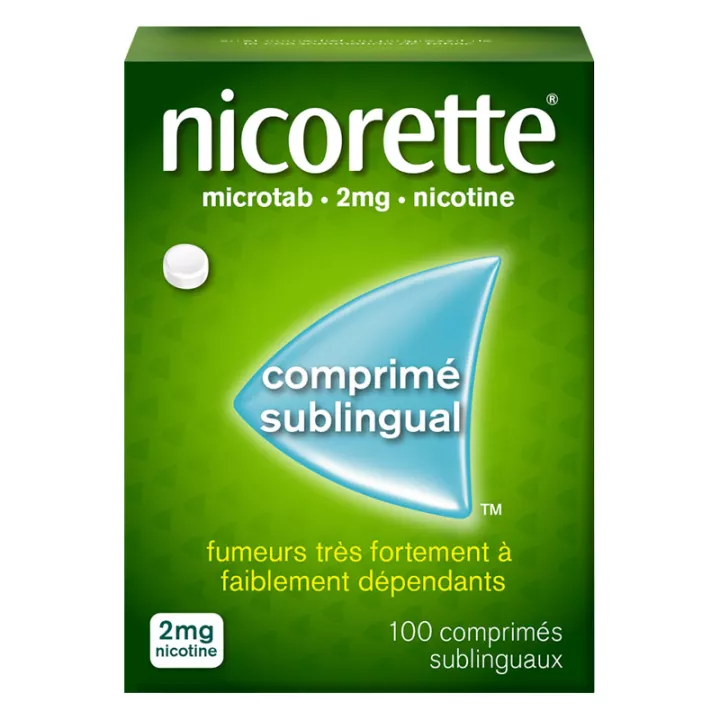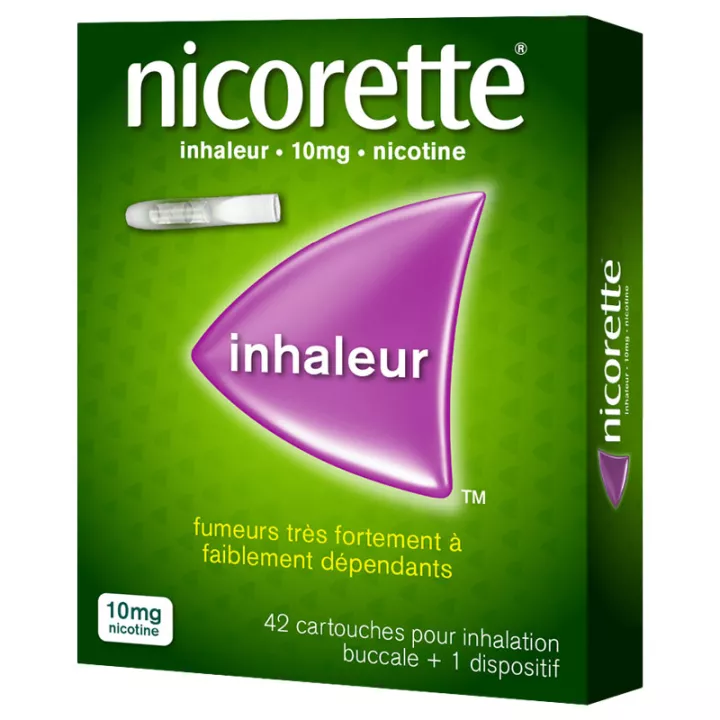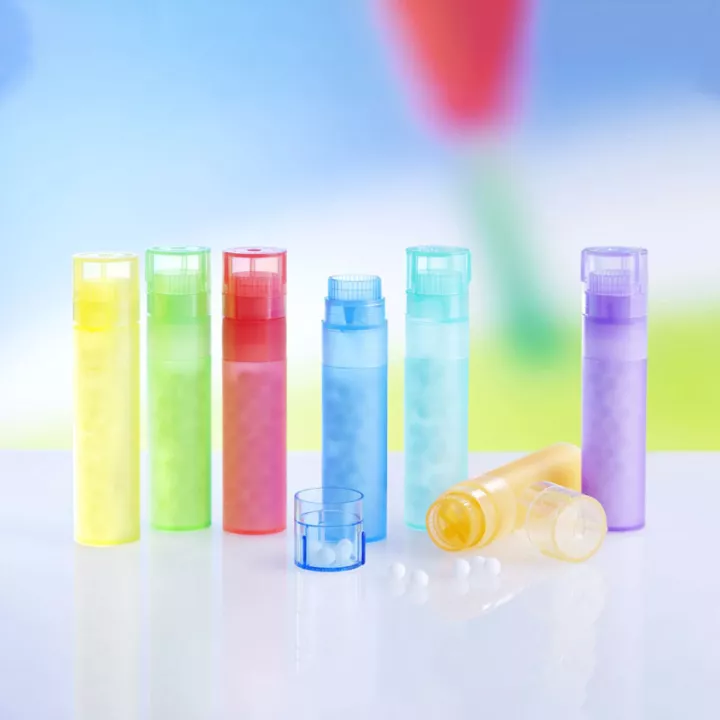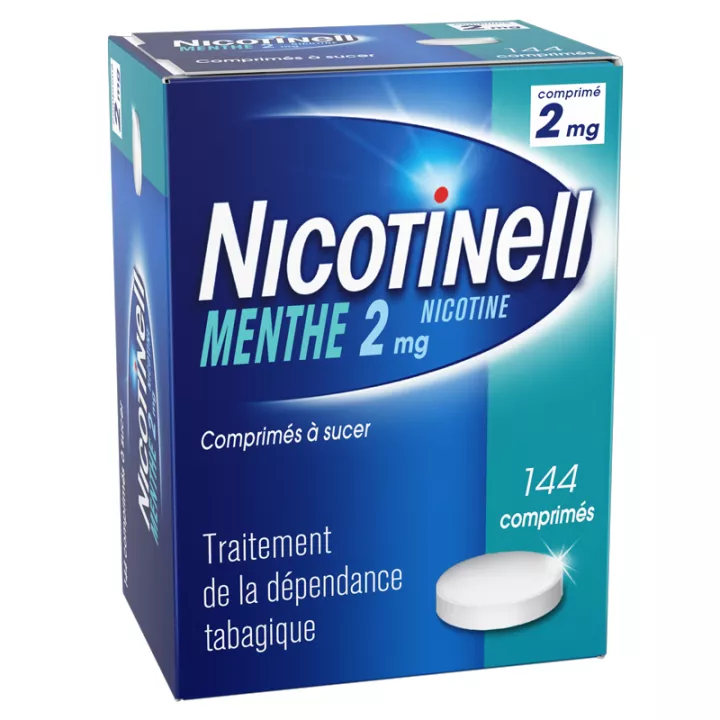NOTICE
ANSM - Last updated: 28/02/2011
Name of the medicinal product
NICORETTE MICROTAB 2 mg, sublingual tablet
Nicotine
framed
Read this leaflet carefully, including the health education tips you will find at the end. The information you will find is important to help you quit smoking.
· This medication is a specialty of AUTOMEDIZATION which can be used without consultation or prescription from a doctor.
· Keep this leaflet, you may need to read it again.
· If you need more information and advice, ask your pharmacist or doctor.
Review summary
In this notice :
1. WHAT IS NICORETTE MICROTAB 2 mg, sublingual tablet AND WHAT IT IS USED FOR?
2. BEFORE YOU TAKE NICORETTE MICROTAB 2 mg, sublingual tablet?
3. HOW TO TAKE NICORETTE MICROTAB 2 mg, sublingual tablet?
4. WHAT ARE POSSIBLE SIDE EFFECTS?
5. HOW TO STORE NICORETTE MICROTAB 2 mg, sublingual tablet?
6. ADDITIONAL INFORMATION
1. WHAT IS NICORETTE MICROTAB 2 mg, sublingual tablet AND WHAT IT IS USED FOR?
Pharmacotherapeutic group
MEDICINAL PRODUCT USED IN NICOTINE DEPENDENCE.
Therapeutic indications
This medication is indicated for the treatment of tobacco addiction in order to alleviate the symptoms of nicotine withdrawal, in particular, the irresistible cravings of smoking in subjects wishing to stop their tobacco consumption.
Tailored management promotes the success rate of smoking cessation.
2. BEFORE YOU TAKE NICORETTE MICROTAB 2 mg, sublingual tablet?
List of information needed before taking the medication
Not applicable.
Cons-indications
Never take NICORETTE MICROTAB 2 mg, sublingual tablet in the following cases:
· if you do not smoke or if you are an occasional smoker,
· in case of allergy to one of the constituents,
· in the case of severe or recent cardiovascular disease (recent myocardial infarction, unstable or worsening angina pectoris, severe heart rhythm disorder)
· in the event of a recent stroke.
If in doubt, it is essential to seek the advice of your doctor or pharmacist.
Precautions for use; special warnings
Take special care with NICORETTE MICROTAB 2 mg, sublingual tablet:
Special warnings
In order to succeed in quitting smoking, complete cessation of smoking is essential. Read health education tips carefully. |
· Some diseases require examination and medical follow-up before using this medication. Thus, in case of :
o heart disease,
o severe or moderate hepatic impairment and / or severe renal impairment,
o thyroid disease,
o diabetes,
o ulcer of the stomach or duodenum in evolution,
o pheochromocytoma (disease of the adrenal glands causing severe hypertension),
It is essential to consult your doctor before using this medication.
· It is imperative to keep sublingual tablets out of the reach of children.
Indeed, the therapeutic dose intended for the adult could cause a serious intoxication or even death in the child.
Precautions for use
· Some signs indicate an under-dosage. If you feel, despite the treatment, a feeling of "lack" like in particular:
o compelling need to smoke,
o irritability, sleep disturbances,
o agitation or impatience,
o difficulty concentrating
Consult your doctor or pharmacist. Indeed, it may be necessary to modify the dosage of the drug.
· Some signs may reflect an overdose : if there are signs of overdose, ie:
o nausea, abdominal pain, diarrhea,
o hypersalivation,
o sweating, headache, dizziness, hearing loss,
o general weakness,
It is imperative to adapt the treatment with the advice of your doctor or pharmacist.
In case of doubt do not hesitate to ask the advice of your doctor or pharmacist.
Interaction with other medicines
Taking or using other medicines
Please tell your doctor or pharmacist if you are taking or have recently taken any other medicines, even medicines obtained without a prescription.
Interactions with food and beverages
Not applicable.
Interactions with Herbal Medicines or Alternative Therapies
Not applicable.
Use during pregnancy and lactation
Pregnancy
It is very important to quit smoking during your pregnancy for you and your child.
Smoking cessation during pregnancy requires medical advice and follow-up. You should therefore consult the doctor who follows your pregnancy or your usual doctor or a doctor at a center specialized in smoking cessation.
feeding
If you smoke a lot and do not plan to stop smoking, you should not breastfeed your child, but use artificial breastfeeding.
The use of this medication should be avoided during breast-feeding.
However, if you want to stop smoking and breast-feed your child, take advice from your doctor or a doctor at a smoking cessation center.
Sport
Not applicable.
Effects on ability to drive or use machines
Not applicable.
List of excipients with known effect
Not applicable.
3. HOW TO TAKE NICORETTE MICROTAB 2 mg, sublingual tablet?
Instructions for proper use
Not applicable.
Dosage, Mode and / or route (s) of administration, Frequency of administration and Duration of treatment
Dosage
Reserved for adults only.
If you are under 18 years of age, this medication should not be used without a prescription.
The number of tablets to use each day depends on your nicotine addiction which can be assessed using the Fagerström test ( see HEALTH EDUCATION ADVICE ).
Treatment of nicotine dependence is usually done in 2 phases.
1 st phase
Take one tablet each time the urge to smoke appears.
If you are low or moderately addicted to nicotine (Fagerström test score 3-6), take one sublingual tablet every 1 to 2 hours to 8 to 12 tablets per day. If you are strongly or heavily dependent on nicotine (Fagerström test score 7 to 10), take 2 tablets per hour, up to 16 to 24 tablets daily, but not more than 30 tablets per day.
The duration of this phase is about 3 months, but may vary depending on the individual response.
2 nd phase
When the urge to smoke is completely overcome, gradually reduce the number of tablets per day.
Treatment will be stopped when consumption is reduced to 1 to 2 tablets per day.
The irresistible cravings to take a cigarette can show again, keep unused tablets.
Duration of treatment
The total duration of treatment should not exceed 6 months. |
However, a longer treatment time may be necessary for some "ex-smokers" to avoid relapse. If you have difficulty with this medication, talk to your doctor.
Administration mode
Mouth.
Place the sublingual tablet under your tongue (or between cheek and gum) and let it dissolve slowly for about 30 minutes.
Warning! the sublingual tablet should not be swallowed or chewed.
Instructions for platelets accompanied by a distributor (with corresponding diagrams)
The plate was specially designed to make it difficult to extract sublingual tablets from children.
· Step 1
1. open the dispenser;
2. Insert the tablet insert in the dispenser on the flat side below;
3. Close the dispenser and make sure it is securely closed.
· 2nd step
4. Rotate the disc until you hear a click;
5. Make sure that one of the notches on the disc is positioned, just in front of the engraved triangle on the dispenser.
6. A sublingual tablet is then in good position to be properly extracted.
· Step 3
7. Press the push button to remove a sublingual tablet and place it under the tongue.
8. To get another tablet, repeat from point 4.
Symptoms and Instructions for Overdose
If you take more NICORETTE MICROTAB 2 mg, sublingual tablet than you should: in case of accidental overdose or if a child has sucked or swallowed a sublingual tablet CONTACT A DOCTOR OR AN EMERGENCY SERVICE.
Severe intoxication may occur and may include hypotension, weak and irregular heartbeat, respiratory discomfort, prostration, cardiovascular collapse and convulsions.
Instructions for omission of one or more doses
Not applicable.
Risk of withdrawal syndrome
Not applicable.
4. WHAT ARE POSSIBLE SIDE EFFECTS?
Description of adverse reactions
Like all medicines, NICORETTE MICROTAB 2 Mg, sublingual tablet is likely to have side effects, although not everyone is subject to it.
Most reported adverse events occur within the first 3 to 4 weeks after initiation of therapy.
Early on treatment irritation or burning sensation of the mouth, irritation of the throat, coughing may appear. In the majority of cases, patients quickly become accustomed to these effects after a few days.
Other side effects reported include headache, dizziness, nausea, digestive problems, hiccups, sore throat, dry mouth, rhinitis, palpitations.
More rarely occurrence of heart rhythm disorder.
Dizziness, headaches, sleep disorders, mouth ulcers may be related to smoking cessation and not to your treatment.
If you notice any side effects not listed in this leaflet, or if any of the side effects gets serious, contact your doctor or pharmacist.
5. HOW TO STORE NICORETTE MICROTAB 2 mg, sublingual tablet?
Keep out of the reach and sight of children.
Expiration date
Do not use after the expiry date stated on the carton.
Storage conditions
Store at a temperature not exceeding 30 ° C.
If necessary, warnings against visible signs of deterioration
Medicines should not be disposed of via wastewater or household waste. Ask your pharmacist what to do with unused medications. These measures will help protect the environment.
6. ADDITIONAL INFORMATION
Full list of active substances and excipients
What does NICORETTE MICROTAB 2 mg contain, sublingual tablet?
The active substance is:
Nicotine ................................................. .................................................. ....................................... 2.00 mg
In the form of betadex nicotine ............................................. .................................................. ....... 17.10 mg
For a tablet.
The other components are :
Betadex, anhydrous colloidal silica, crospovidone, magnesium stearate.
Pharmaceutical form and content
What is NICORETTE MICROTAB 2 mg, sublingual tablet and contents of the pack?
This medication is in the form of sublingual tablets. Box of 30 or 105 with dispenser.
This medication is in the form of sublingual tablets. Box of 20, 30, 90, 100 or 150 with case.
Not all pack sizes may be marketed.
Name and address of the marketing authorization holder and the holder of the manufacturing authorization responsible for the release of the lots, if different
Holder
JOHNSON & JOHNSON SANTE BEAUTE FRANCE
1, rue Camille Desmoulins
92130 ISSY LES MOULINEAUX
exploiting
JOHNSON & JOHNSON SANTE BEAUTE FRANCE
1, rue Camille Desmoulins
92130 ISSY LES MOULINEAUX
Maker
MCNEIL AB
NORRBROPLATSEN 2
25109 HELSINGBORG
SWEDEN
Names of the medicinal product in the Member States of the European Economic Area
This medicinal product is authorized in the Member States of the European Economic Area under the following names:
In accordance with the regulations.
Date of approval of the notice
The last date on which this leaflet was approved is {date}.
AMM under exceptional circumstances
Not applicable.
Internet Information
Detailed information on this medicine is available on the Afssaps website (France).
Information for health professionals only
Not applicable.
Other
ADVICE / HEALTH EDUCATION
As soon as you stop smoking:
· You will not absorb the irritating and toxic substances of cigarettes,
· You will see some improvements: progressive disappearance of headaches, cough, irritation of the throat, shortness of breath,
· You will often have the satisfaction of regaining better sleep, food flavor, odor and improve your physical performance,
· You will reduce your risk of developing lung cancer or cardiovascular disease.
It's never too late to quit even if you've smoked a long time and a lot. |
What is tobacco dependence?
Tobacco addiction is twofold:
· Psychological dependence:
Smoking a cigarette involves a ritual of automatic and repetitive gestures associated with particular circumstances (pleasure, response to stress, intellectual stimulation, support for morale, need for a gesture of conviviality). This is psychological and behavioral dependence.
· Physical dependence:
The need for the nicotine body is due to the effects of this substance on the nervous system. This is physical dependence. Failure to satisfy this need results in a sense of lack (see description in the chapter "How to overcome your physical dependence?").
Nicotinic substitutes aim to treat this dependence.
How to overcome your psychological addiction?
· Stopping smoking is necessary to increase your chances of success, but more:
o Choose a J day in the period that you think is the most favorable.
o Throw away your last pack of cigarettes, your lighter and put away your ashtrays.
o In a couple of smokers, it is preferable that the attempt to stop is made at the same time by both spouses.
· Tell your family and co-workers that you quit smoking. Ask them to respect your decision (no smoking near you, no longer offering you cigarettes).
· Prepare yourself to cope with the desire to smoke. It can occur suddenly and severely, especially during the first few weeks after the cessation of smoking, but does not last more than 3 or 4 minutes.
You have to foresee what you will do in this case and act very quickly so as not to "crack" as for example:
o drink a large glass of water,
o to chew gum,
o counting up to 100,
o do some deep breaths,
o out of the room,
o change activity ...
· Avoid situations associated with taking cigarettes (coffee, aperitif, ...), avoid temptations (settle with non-smokers).
Find cigarette compensation (leisure, sport, cultural activity ...).
How to overcome your physical addiction?
If you are addicted to nicotine, the success of your approach may require the use of nicotine substitutes.
In order to assess your level of dependence, the Fagerström test is offered.
FAGERSTROM TEST
How long after you wake up do you smoke your first cigarette? · within 5 minutes: 3 · from 6 to 30 minutes: 2 · from 31 to 60 minutes: 1 · after 60 minutes: 0 | |
Do you find it difficult to not smoke in places where it is forbidden? · yes: 1 · no: 0 | |
What cigarette of the day would you be the hardest to give up? · the first: 1 · another: 0 | |
How many cigarettes do you smoke per day? · 10 or less: 0 · 11 to 20: 1 · 21 to 30: 2 · 31 or more: 3 | |
Do you smoke at a more sustained pace in the morning than in the afternoon? · yes: 1 · no: 0 | |
Do you smoke when you are so sick that you have to stay in bed almost all day? · yes: 1 · no: 0 | |
TOTAL POINTS | |
score 0 to 2 : you are not addicted to nicotine.
You can stop smoking without the need for nicotine replacement.
If you are concerned about this decision, consult your pharmacist or doctor.
score 3 to 4 : you are weakly dependent on nicotine.
score 5 to 6 : you are moderately addicted to nicotine.
The use of nicotine substitutes will increase your chances of success.
Consult with your pharmacist or doctor to help you choose the treatment best suited to your situation.
score 7 to 10 : you are strongly or very strongly dependent on nicotine.
The use of nicotine substitutes is recommended to help you overcome this addiction to nicotine. This treatment should be used in sufficient and appropriate dosage.
Consult with your pharmacist or doctor, possibly as part of a specialized smoking cessation counseling.
Weaning-related disorders may persist for a long time and the duration of treatment should be sufficient, usually one to three months.
If you feel, despite the treatment, a feeling of persistent "lack" such as:
· compelling need to smoke,
· irritability, sleep disturbances,
· agitation or impatience,
· difficulty of concentration,
Take the advice of your doctor or pharmacist as doses may need to be adjusted.
How do you get help?
· Support from health professionals
The support, advice and follow-up that your doctor or pharmacist can give you will be valuable during the first six months of your smoking cessation. You can also use a specialized smoking cessation counseling, especially if you have already failed.
· Psychological support
Stopping smoking requires a supportive family and social environment. If you are concerned that the difficulties are too great, psychological support or temporary treatment can help.
· Dietetics
In the months following tobacco cessation, you may find moderate weight gain. If you have any concerns in this area, you can contact a health professional who will be able to advise you.
You started smoking again, why?
Consider this relapse as an accident of course, as a normal event that allows to learn: the relapse is not a failure.
Analyze the reasons why you took back the tobacco.
· Because of the physical dependence
This may have been poorly taken into account or reappeared after several months, occasionally, for example, by prolonged stays in smoky atmospheres.
· Because of excessive weight gain
It may be necessary to change your diet somewhat before your next attempt to quit smoking.
· Because of a decline in motivation , because of a painful event or a difficult period, because of psychological difficulties appearing at the cessation of smoking (depression, anxiety ...), because of a situation very tempting. Understand the reason for this relapse to prevent it if possible during the next attempt.
In all cases, do not hesitate to ask for advice from a health professional or to use a specialized consultation to help with smoking cessation.
If you have started smoking again, do not get discouraged, experience shows that your chances of success increase after one or more attempts to quit. |







